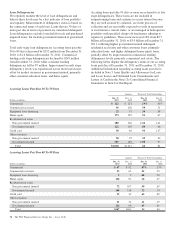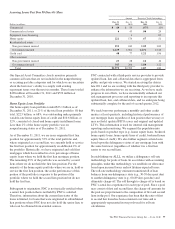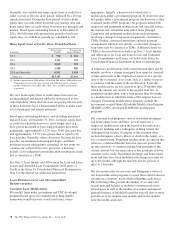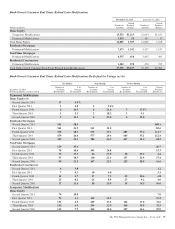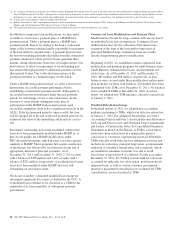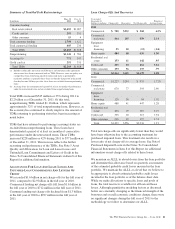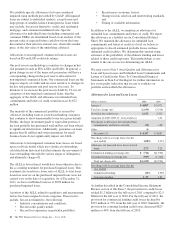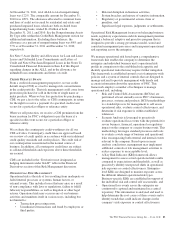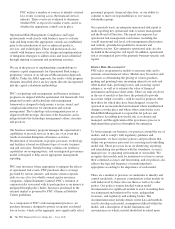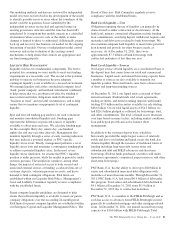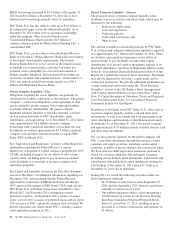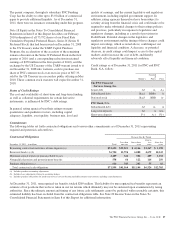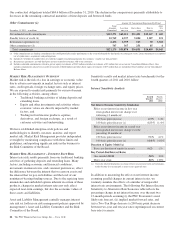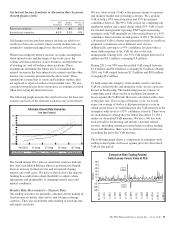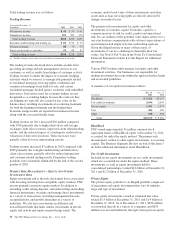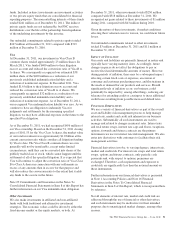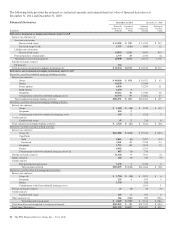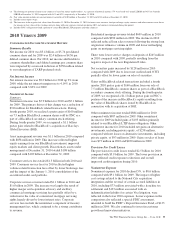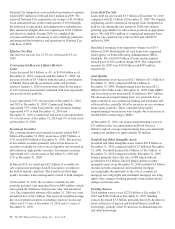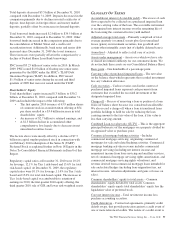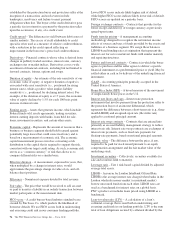PNC Bank 2011 Annual Report Download - page 95
Download and view the complete annual report
Please find page 95 of the 2011 PNC Bank annual report below. You can navigate through the pages in the report by either clicking on the pages listed below, or by using the keyword search tool below to find specific information within the annual report.FHLB borrowings increased to $7.0 billion at December 31,
2011 from $6.0 billion at December 31, 2010 due to $2.0
billion in new borrowings partially offset by maturities.
PNC Bank, N.A. has the ability to offer up to $3.0 billion of
its commercial paper to provide additional liquidity. As of
December 31, 2011, there were no issuances outstanding
under this program. Other borrowed funds on our
Consolidated Balance Sheet includes $4.3 billion of
commercial paper issued by Market Street Funding LLC, a
consolidated VIE.
PNC Bank, N.A. can also borrow from the Federal Reserve
Bank of Cleveland’s (Federal Reserve Bank) discount window
to meet short-term liquidity requirements. The Federal
Reserve Bank, however, is not viewed as the primary means
of funding our routine business activities, but rather as a
potential source of liquidity in a stressed environment or
during a market disruption. These potential borrowings are
secured by securities and commercial loans. At December 31,
2011, our unused secured borrowing capacity was $26.9
billion with the Federal Reserve Bank.
Parent Company Liquidity – Uses
Obligations requiring the use of liquidity can generally be
characterized as either contractual or discretionary. The parent
company’s contractual obligations consist primarily of debt
service related to parent company borrowings and funding
non-bank affiliates. Additionally, the parent company
maintains adequate liquidity to fund discretionary activities
such as paying dividends to PNC shareholders, share
repurchases, and acquisitions. As of December 31, 2011, there
were approximately $4.0 billion of parent company
borrowings with contractual maturities of less than one year.
In addition, we will use approximately $3.5 billion of parent
company cash and short-term investments to acquire RBC
Bank (USA) in March 2012.
See “Supervision and Regulation” in Item 1 of this Report for
information regarding the Federal Reserve’s current
supervisory assessment of capital adequacy program (the 2012
CCAR), including its impact on our ability to take certain
capital actions, including plans to pay or increase common
stock dividends or to reinstate or increase common stock
repurchase programs.
See Capital and Liquidity Actions in the Executive Summary
section of this Item 7 for additional information regarding our
December 2011 announcement that the Federal Reserve
approved the acquisition of RBC Bank (USA) and that the
OCC approved the merger of RBC Bank (USA) with and into
PNC Bank, N.A. with these transactions scheduled to close
March 2012, our November 2011 redemption of trust
preferred securities, our September 2011 issuance of senior
notes, our July 2011 issuance of preferred stock, and our April
2011 increase to PNC’s quarterly common stock dividend. We
did not repurchase any shares under PNC’s existing common
stock repurchase program in 2011.
Parent Company Liquidity – Sources
The principal source of parent company liquidity is the
dividends it receives from its subsidiary bank, which may be
impacted by the following:
• Bank-level capital needs,
• Laws and regulations,
• Corporate policies,
• Contractual restrictions, and
• Other factors.
The amount available for dividend payments by PNC Bank,
N.A. to the parent company without prior regulatory approval
was approximately $1.7 billion at December 31, 2011. There
are statutory and regulatory limitations on the ability of
national banks to pay dividends or make other capital
distributions or to extend credit to the parent company or its
non-bank subsidiaries. See Note 21 Regulatory Matters in the
Notes To Consolidated Financial Statements in Item 8 of this
Report for a further discussion of these limitations. Dividends
may also be impacted by the bank’s capital needs and by
contractual restrictions. We provide additional information on
certain contractual restrictions under the “Trust Preferred
Securities” section of the Off-Balance Sheet Arrangements
And Variable Interest Entities section of this Item 7 and in
Note 13 Capital Securities of Subsidiary Trusts and Perpetual
Trust Securities in the Notes To Consolidated Financial
Statements in Item 8 of this Report.
In addition to dividends from PNC Bank, N.A., other sources
of parent company liquidity include cash and short-term
investments, as well as dividends and loan repayments from
other subsidiaries and dividends or distributions from equity
investments. As of December 31, 2011, the parent company
had approximately $7.8 billion in funds available from its cash
and short-term investments.
We can also generate liquidity for the parent company and
PNC’s non-bank subsidiaries through the issuance of debt
securities and equity securities, including certain capital
securities, in public or private markets and commercial paper.
We have effective shelf registration statements pursuant to
which we can issue additional debt and equity securities,
including certain hybrid capital instruments. Total senior and
subordinated debt and hybrid capital instruments declined to
$16.0 billion at December 31, 2011 from $17.3 billion at
December 31, 2010 due to maturities.
During 2011 we issued the following securities under our
shelf registration statement:
• $1.25 billion of senior notes issued September 19,
2011 and due September 2016. Interest is paid semi-
annually at a fixed rate of 2.70%,
• One million depositary shares, each representing a
1/100th interest in a share of our Fixed-to-Floating
Rate Non-Cumulative Perpetual Preferred Stock,
Series O, issued July 27, 2011, resulting in gross
proceeds to us before commissions and expenses of
$1 billion.
86 The PNC Financial Services Group, Inc. – Form 10-K


